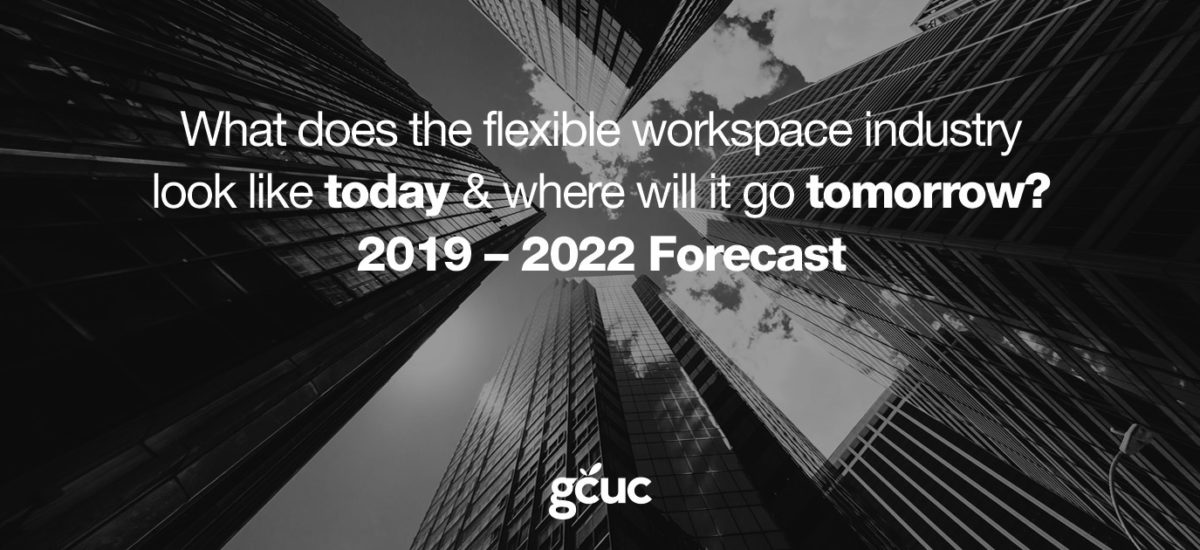The Future looks Juicy – What can we Expect from the Flexible Workspace Industry

Demand for flex workspace increased in 2018 as new markets began to pick up and awareness of workspace options increased among clients. Pricing levels have definitely started to mature in some of the larger markets, but the sector has every reason to be optimistic as we are seeing more and more market activity in secondary and tertiary cities.
As GCUCs’ Global Data Partner, The Instant Group has produced our predictions for what we think the market will look like in the coming years based on our market-leading data. And as you will see in the charts below the future looks juicy!
While the industry will expand to 33,072 centers this year its footprint is starting to change as growth in more mature cities such as London and New York stabilize, and new markets drive the industry forward. These trends play a large part in our short term forecast of +14.4% compound annual growth, which will drive the industry to approximately 49,500 offices by 2022.
What is Behind this Growth?
The major drivers for growth in Western Europe and North America are expected to be the expansion of the industry into secondary and tertiary cities. We have already seen this trend start to take hold, to the large part because of a broader societal trend towards relocation to less expensive areas, with shorter commutes and higher quality of life.
Increasingly, companies are recognizing this desire among their employees to look at alternate locations – away from the “global” cities – and are tailoring their real estate strategy accordingly. Needless to say, high commercial real estate costs and low vacancy rates in office buildings are also playing a role in this.
We should also recognize the impact of what you might term the “WeWork” effect but to put it more simply, the huge increase in awareness among clients of all sizes of alternative ways to occupy office space. Adam Neuman and his gang have done a great job of raising the profile of the sector in the mainstream press, but now the sector as a whole is gaining publicity in a way that didn’t exist even five years ago. And, to give the industry credit where it is due, it has also become a lot better at marketing itself and funnelling client demand.
What Markets are set to Blow Up?
In Eastern Europe, Africa and Latin America we are expecting to see growth figures well above 20% in the coming years, as the quality of space is driven up by new providers and investment. Creating a new explosion of demand from international corporate clients, alongside start-ups and smaller local businesses.
As you will see in the chart below, we predict that by 2021 the expansion in APAC will mean that the industry outsizes the once dominant market of EMEA in terms of the number of centers. While our forecast indicates APAC growth will continue to outstrip the wider global market through to 2022, the geographical focus of this growth will change.
In particular, the focus on China is likely to dim with reports of high vacancy rates dulling new investment and expansion plans for many, while several independent providers are sure to close. Perhaps a warning that even with strong demand, rapid expansion without truly understanding the market dynamics or pricing can still put a business into difficulties.

The Customer is ALWAYS Right!
The growth in supply we are forecasting is expected to be supported by several key changes in demand over the next 3 years. Already we have seen larger corporates with bigger team requirements move into flexible workspace environments and this is certainly something that we expect to see continue going forward. At present, our research indicates that up to 40% of all individuals working within flexible spaces are part of larger organizations and this figure is expected to grow to over 60% by 2022. In response, we predict that the focus from space providers will be on both larger offices but also increased hybrid space utilization.
These hybrid spaces will increasingly provide a larger proportion of private space that will be focused around a core coworking environment with hospitality type services and amenities. These types of space are expected to cater to a mix of SME businesses that want privacy, alongside start-up, freelancers and spill out / drop in space that creates the buzz and atmosphere that many are looking for. The key for operators of these spaces will be to provide services that cater to both groups while creating a sense of community that encourages all occupiers to mix and feel part of something bigger than just themselves.
While we predict demand to continue to grow in all areas for the short to mid-term, we feel that there are 5 key factors that will help stimulate markets both mature and new, to become focal points of the industry over the next 3 – 4 years. As you can see below these factors are seen in several markets that are already leading the industry such as London, New York and Hong Kong while other markets such as Buenos Aires, Bengaluru, Tel Aviv and Toronto all see similar trends and are markets that we expect to become high growth hubs of the industry going forward.

And, in the end…..
2019 and onwards is going to be a fascinating time for the flexible workspace industry with the market seeing high growth in some markets while others continue to mature. Alongside this activity we can expect to see increased investment into the industry, potentially leading to increased consolidation from larger scale providers, while smaller independents continue to look towards niche sectors to carve out sustainable business communities.
During this period of consolidation, we would anticipate technology and data solutions for the sector becoming more sophisticated as operators look to find the answers to the questions this changing market is posing.
As competition increases, we expect to see a short dip in rates in certain markets on the back of short-term oversupply, a natural life cycle for many developing markets. To see our full 2019 predictions please visit our Flex Workspace Trends Report here.







